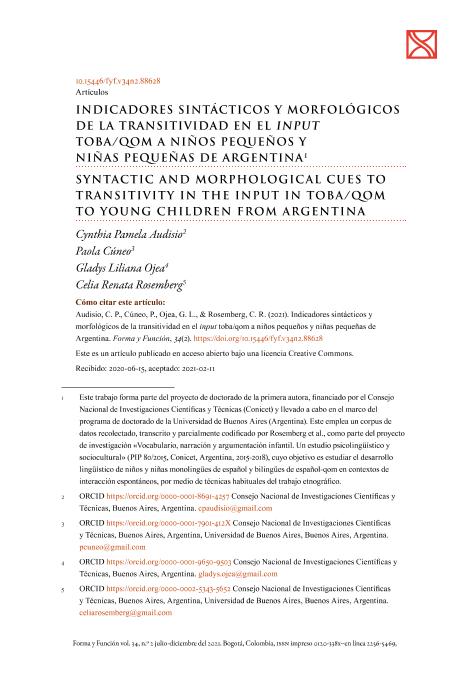Artículo
Investigaciones lingüísticas anteriores han descrito las propiedades formales de la construcción transitiva, que prototípicamente expresa eventos causativos, en distintas lenguas del mundo. No obstante, poco se ha investigado el despliegue de estas propiedades en el habla espontánea y, principalmente, en el input infantil. Esto permitiría determinar la evidencia de la que dispone el/la niño/a para reconocer la construcción e inferir el significado prototípicamente asociado con los marcos transitivos. Este trabajo estudia la frecuencia, consistencia y coocurrencia de indicadores de transitividad sintácticos (cantidad de nominales y orden de constituyentes) y morfológicos (afijos) en el input en toba/qom a tres niños y una niña (M=1;9) de Chaco (Argentina). Los resultados muestran que la omisión de argumentos es frecuente y no hay dos órdenes que discriminen transitividad. Aunque compensan la elisión argumental en 20% del input, los indicadores morfológicos se encuentran mayormente ausentes, en especial en el habla dirigida al niño o la niña. En casi la mitad de la muestra, las propiedades sintácticas y morfológicas no brindan información consistente sobre la transitividad de la cláusula y solo raramente coocurren los valores más consistentes de ambos tipos de indicadores. Previous linguistic research has described the formal properties of the transitive construction, which prototypically expresses causative events, in different languages of the world. However, little has been studied about the unfolding of these properties in spontaneous speech and, especially, in the input to children. This would allow to determine the evidence available to the child so (s)he can identify the construction and infer the meaning prototypically associated with transitive frames. The present work studies the frequency, consistency, and co-occurrence of syntactic (quantity of nominals and order of constituents) and morphological (affixes) transitivity cues on the Toba/Qom input to three male children and a female child (M=1;9) from Chaco (Argentina). The results show that argument omission is frequent and that there are not two orders that discriminate transitivity. Although they compensate for argument elision in 20% of the input, morphological cues are mostly absent, especially in child-directed speech. In nearly half of the sample, the syntactic and morphological properties do not provide consistent information about the transitivity of the clause. The most consistent values of both morphological and syntactic cues rarely co-occur.
Indicadores sintácticos y morfológicos de la transitividad en el input toba/qom a niños pequeños y niñas pequeñas de Argentina
Título:
Syntactic and morphological cues to transitivity in the input in toba/qom to young children from Argentina
Fecha de publicación:
30/07/2021
Editorial:
Universidad Nacional de Colombia. Facultad de Ciencias Humanas. Departamento de Lingüística
Revista:
Forma y Función
ISSN:
0120-338X
e-ISSN:
2256-5469
Idioma:
Español
Tipo de recurso:
Artículo publicado
Clasificación temática:
Resumen
Palabras clave:
Adquisición
,
Input
,
Morfosintaxis
,
Qom
,
Toba
,
Transitividad
,
Lingüística
,
Lenguaje
Archivos asociados
Licencia
Identificadores
Colecciones
Articulos(CIIPME)
Articulos de CENTRO INTER. DE INV. EN PSICOLOGIA MATEMATICA Y EXP. "DR. HORACIO J.A RIMOLDI"
Articulos de CENTRO INTER. DE INV. EN PSICOLOGIA MATEMATICA Y EXP. "DR. HORACIO J.A RIMOLDI"
Citación
Audisio, Cynthia Pamela; Cúneo, Paola; Ojea, Gladys Liliana; Rosemberg, Celia Renata; Indicadores sintácticos y morfológicos de la transitividad en el input toba/qom a niños pequeños y niñas pequeñas de Argentina; Universidad Nacional de Colombia. Facultad de Ciencias Humanas. Departamento de Lingüística; Forma y Función; 34; 2; 30-7-2021; 1-40
Compartir
Altmétricas




